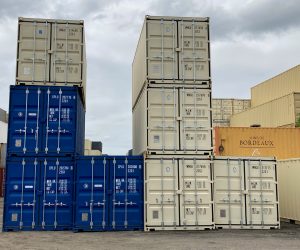
One-time-used shipping containers, often referred to as “one-trip containers” or “like new containers”, are relatively common within the global logistics and storage industry. These containers are designed and manufactured overseas where they are packed and shipped to their destination, typically to the United States or other global markets, and never intended to be returned. This concept of one-time use offers several advantages that make them highly sought after in various commercial and industrial sectors.
Construction and Quality – One-time-used shipping containers are constructed using high-quality corten steel, renowned for its durability and resistance to corrosion. This ensures that even after a single journey, the structural integrity of the container remains intact, meeting international shipping standards. The containers are carefully inspected and certified before shipment to ensure they comply with all safety and quality regulations.
Like-New Condition – Despite being used for just one trip, these containers arrive in the destination country in a condition that is virtually indistinguishable from new. This is due to meticulous handling and the nature of their construction, which prioritizes durability and longevity. Upon arrival, these containers are deemed suitable for a wide range of applications that require pristine condition, such as storage, modified container projects, or even architectural uses.
Economic and Environmental Benefits – The concept of one-time-used containers offers significant economic and environmental benefits. Economically, these containers help reduce costs by eliminating the need to ship empty containers back to their origin. This cost-saving measure translates to lower prices for customers who purchase these containers for various purposes, including storage solutions or temporary structures.
From an environmental standpoint, one-time-used containers contribute to sustainability efforts by maximizing the utility of each container manufactured. By repurposing these containers for secondary uses rather than fabricating new ones, the environmental impact associated with raw material extraction and manufacturing processes is reduced. This aligns with global initiatives to promote resource efficiency and minimize carbon footprints across industries.

Versatility and Applications – One-time-used shipping containers find application across diverse sectors and industries. Their robust construction and like-new condition make them ideal for secure storage solutions in both urban and remote locations. Businesses often utilize these containers for inventory storage, equipment housing, or as temporary office spaces at construction sites or events.
Moreover, the versatility of one-time-used containers extends to creative architectural projects. Architects and designers frequently incorporate these containers into innovative housing solutions, pop-up retail spaces, art installations, and even emergency shelters. Their modular nature and ease of transport allow for flexibility in design and rapid deployment, making them a preferred choice for projects that require both functionality and aesthetic appeal.
Customization and Modifications – One of the significant advantages of one-time-used containers is their adaptability to customization and modification. Companies specializing in container modifications can transform these standardized units into bespoke solutions tailored to specific customer requirements. This may include adding doors, windows, insulation, electrical wiring, HVAC systems, and interior finishes to enhance usability and comfort.
For businesses looking to expand storage capacity quickly or create unique retail environments, modified one-time-used containers offer a cost-effective alternative to traditional construction methods. These modified containers retain their structural integrity while providing a customizable canvas for creative design solutions.
 Purchasing and Logistics – Acquiring one-time-used shipping containers is a straightforward process facilitated by a network of suppliers and distributors. These containers are available in various sizes, including standard dimensions like 20-foot and 40-foot lengths, as well as high cube configurations for added vertical storage space. Customers can purchase containers directly from suppliers or through authorized dealers who ensure compliance with quality standards and offer logistical support for delivery.
Purchasing and Logistics – Acquiring one-time-used shipping containers is a straightforward process facilitated by a network of suppliers and distributors. These containers are available in various sizes, including standard dimensions like 20-foot and 40-foot lengths, as well as high cube configurations for added vertical storage space. Customers can purchase containers directly from suppliers or through authorized dealers who ensure compliance with quality standards and offer logistical support for delivery.
Summary
These containers are ideal for customers who need high-quality containers at a lower cost compared to brand-new ones but still want the assurance of reliability and durability. They are often used for various purposes, including storage, transport, and conversion into portable buildings or other structures.

